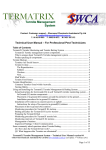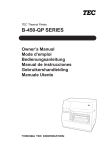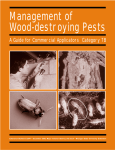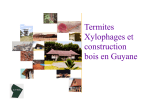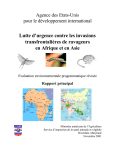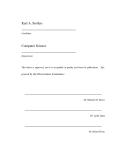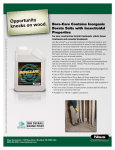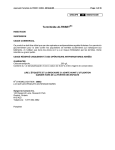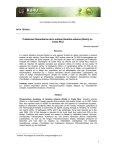Download Monitoring and Baiting system INSTALLATION MANUAL
Transcript
Monitoring and Baiting system INSTALLATION MANUAL For Professional Pest Control Technicians ONLY Revolutionary Termite Baiting Technology SUMITOMO CHEMICAL Sumitomo Chemical Australia Pty. Ltd. has made extensive efforts to ensure that the information contained herein is accurate and conforms to best practices known at the time of publication. However, new approaches to product management, unique aspects of individual situations, and different laws and cultures, require that the reader exercise independent judgement when making decisions affecting the safety of any facility, practice or process. Suggestions for improvements will be warmly welcomed and carefully considered. Copyright © 2013 by Sumitomo Chemical Australia Pty. Ltd. All rights reserved. No part of this publication may be reproduced or transmitted in any form or by any means, electronic or mechanical, including photocopy, recording, or any information storage or retrieval system, without permission in writing from Sumitomo Chemical Australia Pty Ltd . All translation rights are reserved by the publisher. Contents Introduction ..........................................................................................................1 The Target .............................................................................................................2 What are termites ................................................................................................2 What is a termite colony .......................................................................................2 Difference between Termites and Ants...................................................................3 Termite Identication ...........................................................................................3 Nesting Habits ....................................................................................................3 What are the Warning Signs..................................................................................5 The Baiting Concept ............................................................................................5 Why Xterm ..........................................................................................................6 Xterm termite Baiting System ..............................................................................7 Components.......................................................................................................7 IG Stations ..........................................................................................................7 AG Stations.........................................................................................................7 Xterm Bait...........................................................................................................7 Active Ingredient .................................................................................................7 Health and Safety ................................................................................................8 Mode of Action....................................................................................................8 Installation............................................................................................................9 Installing Xterm AG Termite Bait Stations...............................................................9 Placement..................................................................................................10 Installation .................................................................................................10 Luring ........................................................................................................10 Preparing Bait Canisters ..............................................................................11 Inspection ..................................................................................................11 Removal.....................................................................................................12 Installing Xterm IG Termite Bait Stations ..............................................................12 Placement..................................................................................................13 Installation .................................................................................................13 Inspection ..................................................................................................14 Removal.....................................................................................................15 Xterm® Defence against Termites | Monitoring and Baiting System - Installation Manual Copyright © 2013 by Sumitomo Chemical Australia Pty Ltd. i How to Cost a Job ................................................................................................17 Benets of Xterm ........................................................................................17 Authorised Installers ...................................................................................17 Support Material.........................................................................................17 Timber Insurance........................................................................................18 Contacts ....................................................................................................18 Xterm® Defence against Termites | Monitoring and Baiting System - Installation Manual Copyright © 2013 by Sumitomo Chemical Australia Pty Ltd. ii Introduction Sumitomo Chemical Australia Pty Ltd is a global research and development company continually developing better ways to assist Professional Pest Managers control urban pests. This Installation Manual introduces the next generation of chemistry to control termites using baiting techniques. The Xterm system is both a monitoring and baiting system which is used to eliminate whole termite colonies. Baiting addresses environmental concerns by not using toxic chemicals in and around a home. Baiting further addresses structural concerns by not using drilling and injecting techniques that can lead to costly damage and repairs to a home. Xterm puts you the Pest Manager in control. The system is exible enough to allow it to be used as a monitoring and baiting system or either a monitoring system, inspected either by you or the client, or a baiting control system. You own the components, system and the client's details. Xterm allows you to form a close relationship with your client, providing exibility to offer the most appropriate system choice for their needs and situation. This manual will run through: a brief on termites; details of the system; details on installation and provide you with marketing tips for your business. How does Xterm work? The Xterm Termite Baiting System includes both Above-Ground (AG) and In-Ground (IG) components that utilise canisters containing a bait matrix specially designed to maximise termite acceptance. Xterm bait canisters contain the latest insect growth regulator (Bistriuron) which provides fast eradication of subterranean termite infestations. It is easy to handle and install, works without having to drill (like liquid treatments) and is environmentally friendly. The bait attracts termites to the bait stations to feed even when there is a plentiful supply of alternative foodstuff in the area. The slow acting insect growth regulator within Xterm is then taken back to the nest and spread throughout the colony before taking effect. This allows the bait to reach even the Queen and the King. In other words, Xterm targets the heart of the colony. Xterm offers a professional looking, cleaner and non-messy formulation that is easy to install service and monitor. Xterm® Defence against Termites | Monitoring and Baiting System - Installation Manual Copyright © 2013 by Sumitomo Chemical Australia Pty Ltd. 1 The Target WHAT ARE TERMITES? Termites are soft-bodied insects commonly known as white ants. They are small in size (4-11 mm) and have three dened body parts namely, the head, thorax and abdomen. Termite colonies have a number of different looking individuals known as castes. Each caste has its own duties within a colony. The largest member of a termite colony is the queen. Incidentally, the queen is also the longest living insect in the world. Termites are insects from the order Isoptera. The name being derived from their having equally sized wings, iso=equal and pteron=wing. The wings, when present, are long, slender, in two pairs of the same size and shape. These are usually shed following a short nuptial ight after which males and females pair up to start a new colony. However, they are now accepted as the epifamily Termitoidae, of the cockroach order Blattodea. Termites are social insects, characterised by the allotment of labour within the castes with the sharing of food, shelter and resources and cooperation in rearing the young. The castes include the worker, soldier and reproductive. Social groups of subterranean termites are composed of both males and females, unlike most other social insects where the majority of members are females. WHAT IS IN A TERMITE COLONY? THE WORKER CASTE Worker termites are physically and sexually immature males and females. They are the most abundant caste in a termite colony. They undertake the task of foraging for food, food storage, brood caring, nest maintenance, excavating, repairing and building galleries and shelter tubes. Workers are the only caste with the ability to digest the cellulose in wood. This is achieved with the help of agellates in the gut that assist in cellulose digestion. These wingless insects are typically the rst termites seen when an active shelter tube or a piece of infested log is disturbed. THE SOLDIER CASTE Soldier termites are physically and sexually immature males and females whose primary function is colony defense. Many have enlarged jaws that render them incapable of feeding themselves. Therefore, they depend on the workers to provide them with regurgitated food. The wide range of jaw types and large heads provides methods that effectively block narrow termite tunnels against ant entry. They have both anatomical and behavioural specialisations. Termite soldiers are usually blind but in certain families; soldiers that developed from the reproductive line have partly functional eyes. Species identication and other taxonomic work is often conducted using the soldiers' heads, mandibles and nasus due to each species' distinct characteristics. Xterm® Defence against Termites | Monitoring and Baiting System - Installation Manual Copyright © 2013 by Sumitomo Chemical Australia Pty Ltd. 2 THE REPRODUCTIVE CASTE The alates or winged reproductives have two pairs of wings that are equal in size. Alates possess fully functional eyes and can withstand dehydration. This particular caste is often mistaken for a ying ant, an error that results in many not realising that termites exist in the vicinity of their property. The reproductives play an important part in establishing new colonies. There are three types of reproductive in a termite colony known as “Primary”, “Secondary” and the “Tertiary” reproductives. Primary reproductives are swarmers (alates) who have successfully survived the dangers of the dispersal or “nuptial” ight and settled down to lay and nurse the rst brood. When a termite colony becomes too large, and the queen cannot lay sufcient eggs to sustain it, Secondary sexually competent reproductives are produced to ease the queen's burden. Although these secondary reproductives lay fewer eggs than the queen, there can be hundreds of them in an established colony. Their contribution to the egg-laying capacity of a colony can be tremendous and when a queen dies, they can take over the total reproduction requirement. Tertiary reproductives are derived from fully developed workers when a certain part of the colony is isolated from its main colony. These reproductives or ergatoids are wingless and look like big workers. DIFFERENCE BETWEEN TERMITES AND ANTS There are three main morphological differences that distinguish winged termites from winged ants. Termites have beaded antennae that are straight to slightly curved, while ants have a pair of distinct elbowed antennae. Winged termites have a broad waist, unlike that of ants' which is constricted. Termite wings are of the same size, whilst the front pair on ants is much longer. Termite Identication There are over 300 species of subterranean termites found in Australia but only around 30 would be considered pests of structures or useful timber. Knowing the termite species assist in understanding their behaviour which helps in determining the most appropriate termite baiting program. Common Termites found within Australia Coptotermes acinaciformes: is found throughout Australia and is the most destructive of all species of termites. They are approximately 5.8mm in length. Colonies often nest in trees or stumps but can also form nests above ground. They will form subcolonies in buildings and will mud pack in and around damaged timber. Xterm® Defence against Termites | Monitoring and Baiting System - Installation Manual Copyright © 2013 by Sumitomo Chemical Australia Pty Ltd. 3 Termite workings can appear grooved in areas of active feeding. Coptotermes acinaciformes raffrayi are found in WA. C michaelseni are also found in WA. C frenchi are found in southern Australia and a very similar to C acinaciformes but are far more timid and easily disturbed. Nasutitermes: Several species of Nasutitermes can damage timber. Soldier termites are distinguished by their pointed heads. Nasutitermes exitiosus usually build a low mound and is more common across South Australia. Nasutitermes walkeri builds part of its nest on tree branches with the rest constructed in the soil beneath the tree. This genus will mainly attack hardwood such as fence posts and timber decking. Mastotermes darwiniensis: is found mainly north of the Tropic of Capricorn. Being approximately 12.25mm in length. Sub interconnecting colonies are common making control difcult and large destruction of timber in short timeframes is typical of this species. Mastotermes darwiniensis typically devastate buildings, bridges, poles, trees and crops such as sugarcane. Large amounts of earth material is usually found covering activity. [Note: Xterm is not registered for this species]. Schedorhinotermes: Found throughout Australia building fragile nests in places such as old tree stumps, timber buried in the ground, in-lled patios and under replaces. Workings are rather brittle compared to Coptotermes and appear darker than surrounding soil. In timber workings the soldiers are less numerous than workers. Heterotermes: are a signicant pest throughout Queensland, northern WA and the NT. Generally they cause little damage to structural timber, and are typically are found in weathered timber fences, decking and posts. Nesting Habits Subterranean termites can be described in 2 basic groups: 1) Multi site nesters are able to reproduce quickly so that new timber food sources become a potential sub-colony nest, possibly within the same house or area. These include (Heterotermes, Schedorhinotermes, and Mastotermes) 2) Central site nesters have one large queen incorporating a central nest. One activity of the colony is to bring back food to the nest. They can infest multi food sources but cannot reproduce within this new food source. If a large moisture source is available within a structure, they may establish their central nest within the structure above ground, These include; (Coptotermes, Nasutitermes). Factors that inuence a termite's colony behaviour include but are not limited to: Cellulose food sources Moisture Climate Geography Predators Xterm® Defence against Termites | Monitoring and Baiting System - Installation Manual Copyright © 2013 by Sumitomo Chemical Australia Pty Ltd. 4 HOW TERMITES ENTER HOMES/PROPERTIES Termites are in constant movement in the soil in search of food. A property may be safe today but not tomorrow. They can crawl through cracks as thin as a piece of paper to enter our homes. These tiny creatures respond to environmental cues such as moisture and temperature gradients. Foundation cracks, wall joints, gaps around plumbing and pipes are all possible entry points. Although termites are thought to wander about underground at random, there have been studies that indicate otherwise. Termites search areas within tunnels spreading out from the colony in a radial pattern. These search patterns divide and subdivide so that they are able to cover as wide an area as possible. In other words, sooner or later, if a property exists in the area they will nd it. WHAT ARE THE WARNING SIGNS? Termites rarely come to the surface to feed. Most of the time, you will only nd out that they are there when it is too late and damage has occurred. However, there are signs that one could look out for. Swarmers in or around the house, especially near light sources after rain. The presence of mud shelters on foundations or other walls running from the ground upwards in to the house. Sawdust-like “powder” near doors and windows. Stray wings left near doors and windows. Tiny holes on wood surfaces. Paint that has started to bubble on wood surfaces that sound hollow when knocked. Acoustic signals of termites gnawing on and knocking against wood surfaces. THE BAITING CONCEPT Termite baiting systems capitalise on the natural behaviour of termites. The key to this baiting concept is the use of a system that attracts termites to a readily accessible feeding station containing a suitable bait matrix, which is then carried back to the nest. As social insects, termites share their food a process known as trophallaxis. This trait allows slow acting toxicants to be transferred through the colony. It is important that the action of the toxicant is slow enough to allow the termites to feed, travel back to their nest, and share before taking effect. The toxin used in this baiting concept is a chitin synthesis inhibitor, which works by preventing the formation of chitin, a carbohydrate needed to form the insect's exoskeleton. With these inhibitors, an insect grows normally until it molts. The inhibitors prevent the new exoskeleton from forming properly, causing the insect to die. Xterm® Defence against Termites | Monitoring and Baiting System - Installation Manual Copyright © 2013 by Sumitomo Chemical Australia Pty Ltd. 5 WHY BAITS? Conventional termiticide treatments often involve the drilling and pumping of large volumes of chemical into the soil with a variety of associated side effects including disturbance and even property damage. Many structures these days are architecturally designed limiting the ability to apply a complete perimeter treatment, thus reducing their effectiveness. The use of chemicals cannot guarantee colony elimination. In comparison, termite baiting is an environmentally friendly way of treating termite infestations, using very small amounts of a pest-specic chemical in a non-disruptive low hazard application leading to colony elimination. Baits are ideal for all situations, even those sensitive to insecticide use. Why Xterm? A quicker speed of kill than other baits on the market means that there is less input of labour and time by the technician which saves costs. Being able to purchase and install components of the system puts the technician in control; there is greater exibility, there are no lock in contracts, no disclosure of information and no site fees. All these factors lead to Xterm allowing you to have more satised customers. Xterm® Defence against Termites | Monitoring and Baiting System - Installation Manual Copyright © 2013 by Sumitomo Chemical Australia Pty Ltd. 6 Xterm Termite Baiting System Components The Xterm system can be used as an In Ground monitoring system which can be baited once termite feeding is detected. Alternatively an Above Ground baiting system for treatment of active infestations. The Xterm system can also be used as a total integrated system consisting of a baiting and monitoring system. The components are sold separately to allow you the exibility to sell and install the most appropriate system for your client. In-ground stations (IG) The In Ground stations are supplied complete with timbers. They are very robust with entry points for termites to enter and have ample room for bait cartridges to be inserted above the timbers once feeding is detected. The lid is designed in such a way to allow ant baiting to occur to keep the stations free of ants which may affect termite aggregation. A key for easy access is also included. The standard concrete lid can be used with Xterm if drilling is required. Above-ground stations (AG) AG stations contain 2 x 60 gram shrink wrapped bait canisters. Screws are included for attachment and lid security. Xterm Bait Xterm bait is a pelletised alpha-cellulose matrix. This formulation is containerised in plastic canisters that t neatly into the IG and AG bait stations. These pellets have a number of advantages: They exploit termites' natural tunneling behaviour and maximise the surface area that termites have to graze on. The pellets are very hygroscopic. Being containerised there is no messy slurry to mix up. The bait comes in: 120g canisters for IG stations. 60 g canisters for AG stations. A tube, containing the alpha-cellulose bait matrix with no active will be sold. By just adding water this turns into a paste that can be used for luring termites to the AG bait if required. Active Ingredient Xterm contains 10g ai/Kg of Bistriuron. Bistriuron belongs to the Benzoylurea group of Xterm® Defence against Termites | Monitoring and Baiting System - Installation Manual Copyright © 2013 by Sumitomo Chemical Australia Pty Ltd. 7 products that are chitin synthesis inhibitors (moult inhibitors). The advantages this new active brings are: Faster acting. Xterm will bring about colony elimination quicker. Higher loading, Xterm has a higher loading of active ingredient, thus there is less bait required to cause colony elimination. Fuss free installation. Xterm is in neat, professional canisters that can be placed in the stations with no mess. The unique formulation allows it to be applied wet or dry, increasing exibility of use. Health and Safety The toxicology of Xterm is benign. It has: Acute Oral (>5000mg/kg) Acute dermal (>2000mg/kg) Acute inhalation (>4mg/L) No irritation or sensitization Non-carcinogenic or teratogenic Mode of action Xterm being a chitin inhibitor means when termites consume Xterm they are unable to form normal cuticle because the ability to synthesis chitin is lost. In the absence of chitin, the cuticle becomes thin and brittle and unable to support the termite or withstand the rigours of moulting. When a termite that has consumed Xterm moults, the effects are immediate; they either die or are incapacitated by their inability to complete the moulting process and then die; with workers becoming sluggish, disorientated and exhibiting abnormal behaviour; they then stop feeding on timber and stop nest building activities. They take on a chalky white appearance before death. Xterm only acts on termites that moult. Thus reproductive termites are not eliminated by Xterm directly. The effects that Xterm has on workers eliminate both non-moulting and non-self- feeding termites. The food that is transferred contains Xterm; then with reduced worker numbers the colony's food source runs out and the colony maintenance ceases causing growth of pathogens such as fungi; thus the colony perishes. Termites cannot detect Xterm, thus moulting termites are unable to avoid its affect. Xterm® Defence against Termites | Monitoring and Baiting System - Installation Manual Copyright © 2013 by Sumitomo Chemical Australia Pty Ltd. 8 Installation In accordance with AS 3660.2, a termite inspection must be carried out on premises and a report produced before any termite control system or monitoring system is installed. Details of the treatment method, the PCO's obligation and the property owners obligations are outlined in the Xterm Contract document. The Xterm termite baiting system works best as a partnership between the pest control operator and the property owner. The householder or business owner can take some simple steps to assist in the effectiveness of the Xterm baiting and monitoring system. Remove any loose timber or trash from underneath and/or around the premises. This includes any dead tree stumps and replacing any untreated timber garden walls or retaining walls with termite resistant materials. Reduce moisture by xing faulty plumbing and improving drainage. Ventilation of suboor areas is crucial to reducing moisture, so ensure these areas are properly ventilated. Gardens or soil or loose materials should be moved back from the house to expose weep holes and the edge of the concrete slab if applicable. Ensure that your customer understands the system, monitoring intervals, bait and all costs well, as it will avoid confusion later on. INSTALLING XTERM AG TERMITE BAIT STATIONS Before installation of the Xterm baiting system, it is recommended you have the following items. Torch Screwdrivers (Phillips & at-head) Soft brush Utility knife Distilled water and disposable syringe Disposable latex gloves (non-powdered) Double-sided tape Masking tape (acceptable colour) Selleys No-More Gaps IMPORTANT It is essential that hands are meticulously cleaned before handling the components of Xterm. Any contamination including that from cigarettes may deter termites from entering Xterm® Defence against Termites | Monitoring and Baiting System - Installation Manual Copyright © 2013 by Sumitomo Chemical Australia Pty Ltd. 9 the bait stations. As an added precaution it is also advisable to wear non-powdered disposable latex gloves when handling Xterm, which should be disposed of after each use. Xterm components (bait stations and canisters) are wrapped in protective plastic that should only be removed at the time of placement. PLACEMENT - XTERM AG Before installing Xterm AG bait stations, it is crucial to determine the location(s) of feeding termites. This can be done by inspecting for the presence of mud tunnels or termite damage on foundation walls, wooden or other cellulose materials, door and window frames. Another tell-tale sign would be the presence of swarmers, which typically leave behind piles of shed wings, indicating that a nest is nearby. Termites will excavate wood until a thin surface layer remains. These surfaces may appear normal until probed. Hollowed out wood can be identied by tapping with a blunt object. If a hollow thud is heard, dig a little and look for termites. Active sites will be located during your termite inspection. Strategic AG bait station positioning is crucial as it will determine the speed that termites enter and feed. Xterm AG Bait Stations MUST be placed on or near areas where termites are active. INSTALLATION Once installation sites have been determined, prepare the bait stations by removing them from their protective plastic. Attach double-sided tape to the base of the station and ensure that it is sufcient to hold the bait station plus canister in place. Screws or a nonsilicon base sealant can also be used to give extra hold if necessary. Press the opening of the base as close to the active termite tunnels as possible. Ensure that the bait station is rmly held in place. Not all surfaces are uniform or the same size as the Ag station. The AG is exible and the back may be taped up if securing to smaller pieces of timber. When installing, remember that the bait station has to draw termites in from their current food source. Making the bait station air and light proof can help. LURING Before preparing the bait canisters, Xterm lure bait may be applied to draw termites' in from their feeding sites to the bait stations. Add distilled water to the required quantity of Xterm™ Lure Bait to form a paste. Apply this near termite mud tube openings so as to create a line of what is effectively a “cellulose highway” leading to the Xterm™ AG station. Xterm® Defence against Termites | Monitoring and Baiting System - Installation Manual Copyright © 2013 by Sumitomo Chemical Australia Pty Ltd. 10 PREPARING AND INSTALLING BAIT CANISTERS Remove the canister protective plastic lm. With a disposable syringe, add 25 ml of distilled water to the bait canister (preferably an even distribution of moisture to all the pellets in the canister). The amount of water may vary. In summer the bait may require more moisture than winter up to 30% more. Slot the canister into the bait station. Up to two bait canisters may be used in one bait station at any one time. Close the station cover. Seal the lid and edges of the bait station with masking tape. Sealing the base will also help make the station more attractive to termites. Once all potential openings are covered, the bait stations should be left undisturbed until the next inspection. There is a screw slot in the lid when shut a self-tapping screw can be applied to secure the lid from opening. INSPECTION FIRST INSPECTION In general, the rst inspection should be conducted three weeks after installation. If feeding termites are present, close the lid and re-seal. Where termites are not found inside the bait stations, examine the bait canisters and add water if the pellets appear dry. If an extended period to the next inspection is necessary, and one canister was initially used, a second canister may be inserted and the bait station re-sealed. SUBSEQUENT INSPECTIONS The schedule for the next inspection will be based on termite activity, estimated rate of bait consumption and the number of bait canisters used. For stations with one canister, re-inspect within 3 to 6 weeks. If termite activity continues, slot in a second bait canister next to the one already in place. Do not disturb the rst canister, close the lid and re-seal. After 9 weeks it would be normal to see much reduced or even no termite activity. If still active, termite control will most likely occur before the next inspection. During inspection, it is essential to minimize any disturbance of feeding termites, so ensure station inspection times are kept short. When swapping Xterm bait canisters ensures minimum disturbance to feeding termites. WHEN DO YOU KNOW THE TERMITES HAVE GONE? There are various indications of successful termite eliminate. The most obvious being a lack of activity within the bait stations. This can be associated with the presence of scattered termite carcasses inside the stations, often covered in mould. If live termites remain, they will appear weak, lost or disoriented. Another sign would be a noticeable change in the termite worker to soldier ratio. When soldier numbers become higher than Xterm® Defence against Termites | Monitoring and Baiting System - Installation Manual Copyright © 2013 by Sumitomo Chemical Australia Pty Ltd. 11 workers, the chances are the colony is close to elimination. The colony may be eliminated within 8 to 9 weeks of the commencement of Xterm baiting, but this process may take longer. Factors effecting time to elimination are: Presence of toxic chemicals from previous treatments. Size and number of colonies. Termite species. Season, cold weather slows down termite metabolism. The distance from bait to nest. Quantity of other feeding sources. Human disturbance of termites. Summary indicators of colony elimination 60g or more of Xterm has been consumed. Behavioural changes in colony members, sluggish. Colouration change of workers. Increase in number of soldiers to workers. Total termite numbers decrease over time. No termite activity recorded in IG or AG stations or anywhere on the property for 6 weeks or two visits after last sightings. REMOVAL OF XTERM AG BAIT STATIONS Once it is conrmed that termite activity has ceased, remove the bait stations and contents; the stations may be used again or if damaged wrapped with the bait canisters and placed in the garbage. Take care not to further damage surfaces to which the stations were adhered. INSTALLING XTERM IG TERMITE BAIT STATIONS Before installation of the Xterm baiting system, it is recommended you have the following items. Torch Soft brush Utility knife Distilled water and disposable syringe Disposable latex gloves (non-powdered) Earth auger (for installing Xterm IG bait station) and concrete core drill Needle-nose pliers or wire hook for retrieving the IG canisters Xterm In Ground Bait Station cover key Xterm® Defence against Termites | Monitoring and Baiting System - Installation Manual Copyright © 2013 by Sumitomo Chemical Australia Pty Ltd. 12 IMPORTANT It is essential that hands are meticulously cleaned before handling the components of Xterm. Any contamination including that from cigarettes may deter termites from entering the bait stations. As an added precaution it is also advisable to wear non-powdered disposable latex gloves when handling Xterm, which should be disposed of after each use. Xterm components (bait stations and canisters) are wrapped in protective plastic that should only be removed at the time of placement. PLACEMENT When choosing suitable locations for the installation of Xterm IG Termite Bait Stations, ensure that the area is favourable to foraging termites. This would include places where there is an obvious water or food source (cellulose material). Areas near foundation walls, air conditioning units, irrigation systems, woodpiles and tree stumps are particularly favoured by termites. When installing the Xterm IG Termite Bait Stations, it is best to place them around the entire structure to create a rst line of defense against foraging termites. Bait stations should be installed at approximately 3 metre intervals. A site map plan should then be drawn paying close attention to ensure stations are placed in high risk areas. Stations should be numbered and noted on the site map for future access. Rotting timber creates low level of CO2 which has been shown to act as an attractant to termites as they associate higher levels of CO2 (than found in ambient soil) with nest vicinity or food. The large Xterm IG stations contain mountain ash timber billets, which once installed act as a food source. INSTALLATION Suitably sized holes should be dug at 3 meter intervals around the structure to be protected. This is best done with an earth auger or other similar tool. Once completed, the Xterm IG stations may be pressed into place, ensuring that the top rim is ush with the ground surface. Xterm IG Bait Stations have an ant bait station incorporated in the underside of the lid. In situations where ants are active, use of an ant bait is recommended (NOTE: the presence of ants is known to deter termite activity). Once the Xterm IG stations are in place eight (8) mountain ash billets should be place in the stations and the cap placed on top and locked. NOTE: Termites randomly forage through the soil and typically take paths of least resistance that provide safety and moisture, hence it is important to loosely pack the soil preferably with sand around the perimeter of the station. Xterm® Defence against Termites | Monitoring and Baiting System - Installation Manual Copyright © 2013 by Sumitomo Chemical Australia Pty Ltd. 13 Sandy soils: If installing in dry sandy soils it will be easier to excavate the soil if the sand is wetted prior to auguring the hole. In addition the placement of cardboard around the perimeter of the station can keep sand from lling up the station whilst providing a cellulose attractant to entice termites. Clay soils: If installing in clay soils a slightly deepened hole will allow for water and soil to be drained from the station. Clay soils are not ideal in areas of high rainfall as the stations ood easily, thereby possibly rendering them inaccessible by termites. Stony soils: difcult to auger holes may require a tungsten tip auger. All lawn thatch, gravel and mulch should be removed from the surface before the station is installed. Often homes and commercial premises have concrete pathways fully or partially around the buildings. In these cases stations should be placed in the concrete. This requires core drilling of the concrete to place the timber billets or station in, with a concrete lid. Note: Before starting any coring, it is important to locate any utility lines and pipes so that costly or dangerous damage can be avoided. INSPECTION As a general rule, the initial inspection and subsequent inspections for non-active sites should be made every 8-12 weeks for monitoring purposes for the length of the contract. If termites are found feeding on the Xterm IG Termite Monitoring timbers, gently place an Xterm IG Termite Bait Canister on top and secure the cover as quickly as possible. Termite activity is commonly associated with the presence of soil in and around the baits. If a visual inspection is not possible with the timbers in situ, inspect the underside of the timbers after rst gently pulling one out with a pair of needle-nose pliers. If termites are found, remove the canister protective plastic lm. With a disposable syringe, add 50 ml of distilled water to the bait canister (preferably an even distribution of moisture to all the pellets in the canister). The amount of water may vary. In summer the bait may require more moisture than winter, up to 30% more. Then slot the canister into the bait station and close the cover. Xterm IG stations with known termite activity should be monitored at intervals to allow for canister replenishment before depletion. Inspection intervals will depend on termite activity inside the bait station and the estimated bait consumption rate and should normally be 3 weeks from placement of the rst Xterm IG Termite Bait Canister and then 3 to 6 weeks for subsequent visits. Bait Stations may be inspected and baits replenished as often as required by the pest manager. The Xterm IG Termite Baiting System is unique. Other products attract termites to Xterm® Defence against Termites | Monitoring and Baiting System - Installation Manual Copyright © 2013 by Sumitomo Chemical Australia Pty Ltd. 14 monitoring bait, that is then removed, and the termites transferred on to the bait before its placement into the bait station. The Xterm IG Termite Baiting System on the other hand does not require the monitoring bait to be removed, so greatly reducing disturbance to the feeding termites, resulting in faster action. One 120g canister should be sufcient for colony elimination, but if the canister is being depleted with termites still present, remove the empty bait canister and insert another canister. Management of stations There are pests that will invade termite IG stations such as ants which will make your station highly unattractive for termites. The most common reason for station invasion is due to poor station installation in that the station top does not sit ush with the soil surface. These gaps that appear under the station top may allow ants to enter and occupy stations. The following are some helpful hints to rectify problems with station invaders; Ants – apply a gel bait or granule to the underside of the station lid. (Due to the unique design contamination of cellulose material is prevented unlike other systems). Wood slaters – remove from the station and replace with fresh timber interceptors. Earthworms – remove from the station Slugs – remove from the station Other pests – general maintenance of stations is critical. WHEN DO YOU KNOW THE TERMITES ARE ELIMINATED? The indications that termites have been eradicated are the same as for AG baiting. The most obvious being a lack of activity within the bait stations. This can be associated with the presence of scattered termite carcasses inside the stations, often covered in mould. If live termites remain, they will appear weak, lost or disoriented. Another sign would be a noticeable change in the termite worker to soldier ratio. When soldier numbers become higher than workers, the chances are the colony is close to elimination. Conrmation that termites are no longer active can only be achieved by means of continued monitoring of the stations and property, if no termites are found for two visits after the last termite was seen it would be assumed that the colony is eliminated. REMOVAL OF XTERM IG BAIT CANISTERS Once it is conrmed that termite activity has ceased, remove and dispose of the used Xterm IG Termite Bait Canisters by wrapping and placing in the garbage and replace these with a fresh Xterm IG Termite Monitoring timbers. Continue inspections at recommended intervals. Xterm® Defence against Termites | Monitoring and Baiting System - Installation Manual Copyright © 2013 by Sumitomo Chemical Australia Pty Ltd. 15 ANNUAL RENEWAL/REFURBISH Every 12 months an annual termite inspection is required and refurbishment of the IG stations. The stations should be opened up, and old timbers and mud (dependent on environmental pressures) removed and new timbers inserted. DISPOSAL Used Xterm bait stations and canisters must be disposed of properly in accordance with local regulations. Xterm® Defence against Termites | Monitoring and Baiting System - Installation Manual Copyright © 2013 by Sumitomo Chemical Australia Pty Ltd. 16 How to cost a job? Measure the property and all building accurately in linear meters below the drip line. Allow for an in ground station every three (3) meters. For active termites install as many above ground stations as entry points or feeding locations are found. Ensure you cost your labour for monitoring and relling stations is included. Don't forget the initial termite inspection and all materials. We have an easy spread sheet for you to use to assist in this process. [Note: no site fees or administration costs with Xterm, once you purchase your materials you are in control.] BENEFITS OF XTERM Latest generation Insect Growth Regulator Faster acting Fuss-free installation No drilling/pumping of chemicals in the home Environmentally sound Unobtrusive bait station design Unique, highly attractive compressed cellulose formulation No site fee or system fee No disclosure of site or client information Flexible components Research and developed by Sumitomo Chemical Australia Pty Ltd Unique and robust station design Authorised Installers Only authorised and trained technician have access to the secured web site and are promoted on our web site. Support Material Home owner brochure How to sell brochure Web siteRenewal document MSDS/Label Technical backup and support Forms Quote contract Costing spreadsheet / quotation ap Xterm® Defence against Termites | Monitoring and Baiting System - Installation Manual Copyright © 2013 by Sumitomo Chemical Australia Pty Ltd. 17 Timber insurance A timber insurance policy is offered on a property that has a Termite Monitoring & Baiting Program implemented. Termite activity could have been located during the termite or timber pest inspection or the Monitoring & Baiting program may be chosen to help protect a property by detecting termite attacks. As your clients property always remains susceptible to having future attack from other or new termite colonies the monitoring stations are left in place and the regular monitoring continues. Once the colony is eliminated, your inspector can issue you with a Timber secure insurance policy. It covers up to $100,000 timber replacement for all structural and decorative timbers and makes good repairs to the areas damaged by termites. It is a 5 year policy and is only available to those PCO's insured through Rapid Solutions. This can be used as a sales tool by you to the household. Please contact Rapid solutions for further details. Contacts Sumitomo Chemical Australia Pty Ltd 51 Rawson Street EPPING NSW 2121 Phone: 02 87529000 www.xterm-sumitomo.com.au Xterm® Defence against Termites | Monitoring and Baiting System - Installation Manual Copyright © 2013 by Sumitomo Chemical Australia Pty Ltd. 18 SUMITOMO CHEMICAL Sumitomo Chemical Australia Pty Ltd A B N: 21 081 096 255 51 Rawson Street EPPING NSW 2121 Phone: (02) 8752 9000 www.xterm-sumitomo.com.au
























